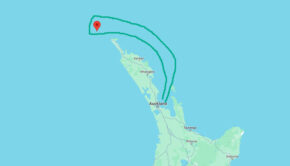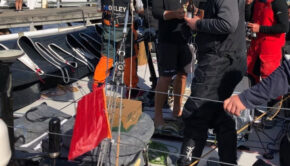Defining sailing “by the lee”
Published on September 23rd, 2021
The racing rules allows for fair competition, but it is a challenge to understand every scenario. To help facilitate the process, the Racing Rules of Sailing Forum offers an opportunity for experts to voice opinion, and Jim Archer was questioning a definition:
We all know these, but from definitions:
• Tack, Starboard or Port: “A boat is on the tack, starboard or port, corresponding to her windward side.”
• Leeward and Windward: “A boat’s leeward side is the side that is or, when she is head to wind, was away from the wind. However, when sailing by the lee or directly downwind, her leeward side is the side on which her mainsail lies. The other side is her windward side. (emphasis added)”
One thing I have noticed about the rules is that some things are left undefined. In this case, sailing by the lee. The commonly understood meaning of this term is that is you’re not quite DDW, perhaps the wind is a few degrees from your port quarter, and the main is on the same side (so port side).
I was sailing along in a race last weekend, going downwind with a spinnaker up at about 150 degrees TWA. Someone suggested that we put the boom on the port side to gain a starboard tack advantage. If I gybed the main I expect it would have stayed.
So, if the main stays where it is, without any preventer or human holding it, is that “sailing by the lee?” Is it “sailing by the lee” if we do hold it? I personally think the rules should address this, but is there an answer in any of the cases?
—————
From Rob Overton
Nationality: United States of America
Certifications: National Judge, International Umpire
It’s true the term “by the lee” isn’t defined. The rules-writers try to avoid cluttering up the rulebook with defined terms when the meaning of the terms in ordinary [nautical] English is both clear and appropriate to the rules application. Happily in this case, it’s not necessary to know exactly what “by the lee” means.
A boat’s tack when sailing downwind or by the lee (notice that we don’t have to decide which of these conditions apply) is the side on which her mainsail lies (emphasis added). To me, at least, “lies” clearly indicates the side on which the mainsail can be set, with the wind filling it from astern.
This doesn’t prohibit the boom from being restrained (for example, by a preventer or a crew member), but it does mean that, if the sail is backwinded, the boat’s tack determined by the side of the boat the wind is from, not by where her boom is being held.
A boat that becomes overlapped to leeward of another boat from clear astern sometimes tries to avoid breaking rule 17 by gybing and then gybing back. That way, the boats are briefly on opposite tacks, and when she gybes back they are overlapped, so rule 17 does not apply.
However, if the leeward boat simply brings her boom past her center-line and then throws it back to the original side, she has not changed tacks because her boom was never lying on the new side.
—————
For more responses, click here.









 We’ll keep your information safe.
We’ll keep your information safe.